#rudolph valentino prize
Explore tagged Tumblr posts
Text










Very sad to hear of the passing of American record producer, songwriter, composer, arranger, and film and television producer Quincy Jones (1933-2024)
Quincy Jones, the multi-talented music titan whose vast legacy ranged from producing Michael Jackson’s historic ���Thriller” album to writing prize-winning film and television scores and collaborating with Frank Sinatra, Ray Charles and hundreds of other recording artists, has died.
He was 91 years old.
He died at his home in the Bel Air section of Los Angeles, surrounded by his family. No cause of death was given.
Quincy Delight Jones Jr. born March 14, 1933 in Chicago Illinois rose from running with gangs on the South Side of Chicago to the very heights of show business, Jones kept company with presidents and foreign leaders, movie stars and musicians, philanthropists and business leaders. He toured with Count Basie and Lionel Hampton, arranged records for Sinatra and Ella Fitzgerald, composed the soundtracks for “Roots”and “In the Heat of the Night,” organized President Bill Clinton’s first inaugural celebration and oversaw the all-star recording of “We Are the World,” the 1985 charity record for famine relief in Africa.
In a career which began when records were still played on vinyl at 78 rpm, top honors likely go to his productions with Jackson: “Off the Wall,” “Thriller” and “Bad” were albums near-universal in their style and appeal. For “Thriller,” some of the most memorable touches originated with Jones, who recruited Eddie Van Halen for a guitar solo on the genre-fusing “Beat It” and brought in Vincent Price for a ghoulish voiceover on the title track.
His list of his honors and awards include 28 Grammys, Two honorary Academy Awards and an Emmy for “Roots.” He also received France’s Legion d’Honneur, the Rudolph Valentino Award from the Republic of Italy and a Kennedy Center tribute for his contributions to American culture. He was the subject of a 1990 documentary, “Listen Up: The Lives of Quincy Jones” and a 2018 film by daughter Rashida Jones. His memoir made him a best-selling author.
My Condolences to his Family Members and Friends.
#R.I.P. 😔🙏🥀🎼
3 notes
·
View notes
Text
MOVIES on TV!
Part 1 ~ The Movies of “I Love Lucy”
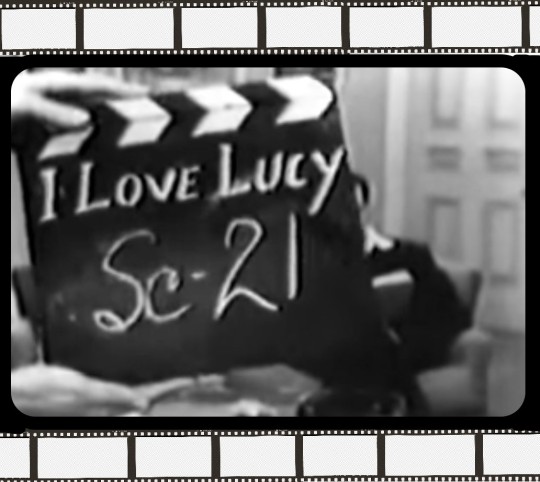
When “I Love Lucy” premiered in 1951, Lucille Ball was a bona fide movie star. By contrast, her creation Lucy Ricardo was a fan - idolizing film stars and Hollywood.
~FACTUAL FILMS~
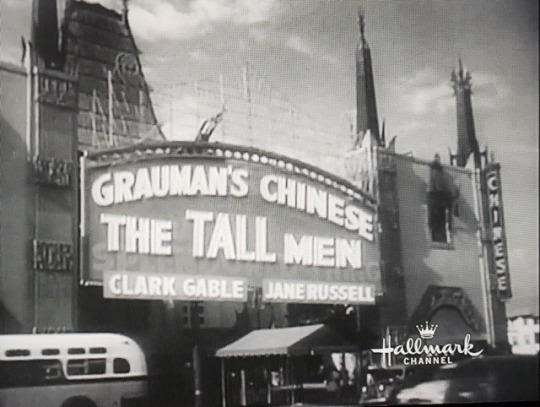
THE TALL MEN ~ “Lucy Visits Graumans” (1955)
Other than this establishing shot, there is no mention of the film, which starred Clark Gable and Jane Russell. “Lucy” actors Will Wright and Harry Shannon were also in the cast. It premiered at Graumans on September 22, 1955.
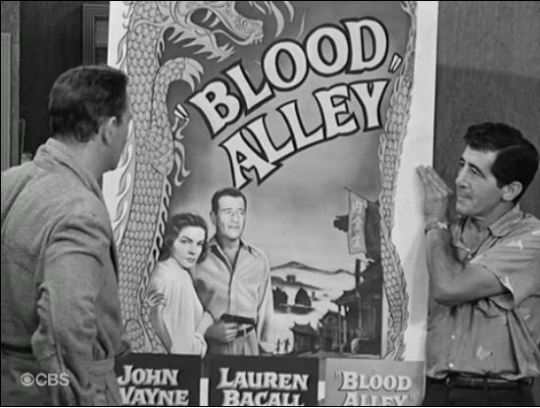
BLOOD ALLEY ~ “Lucy and John Wayne” (1955)
The film is promoted by Wayne approving of a large poster of the film, which co-starred Lauren Bacall.
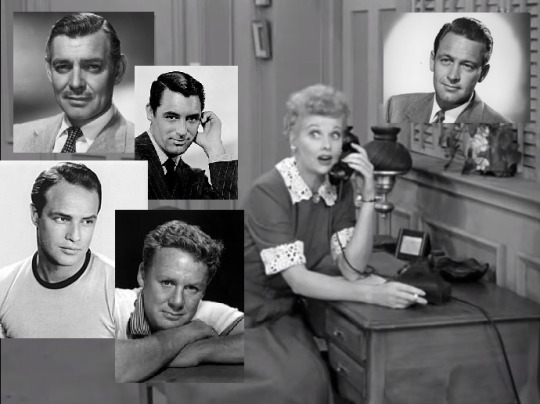
SABRINA ~ “Getting Ready” (1954)
LUCY: (on the phone) “Would you like me to give a message to any of the gang out there? You know, Clark or Cary or Van or Marlon? Oh, all right. (writing) Tell Bill Holden that Marion Van Vlack saw ‘Sabrina’ five times!”
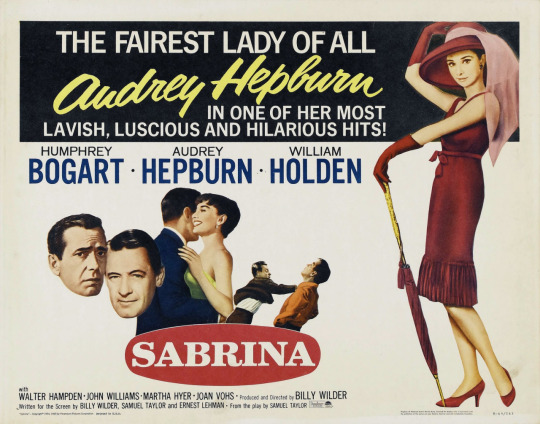
Sabrina is a 1954 romantic comedy-drama directed by Billy Wilder, based on Samuel A. Taylor’s play Sabrina Fair. In addition to Holden, the movie starred Humphrey Bogart and Audrey Hepburn. “I Love Lucy” character actors Ellen Corby and Nancy Kulp play supporting roles.
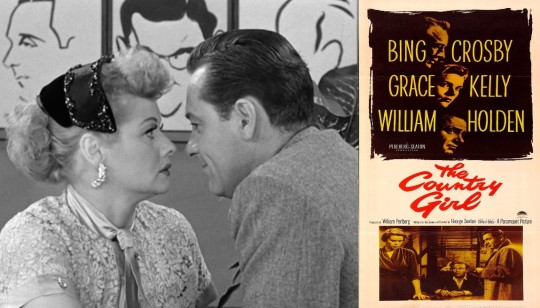
THE COUNTRY GIRL ~ “L.A. at Last” (1955)
William Holden promotes his latest film co-starring Bing Crosby and Grace Kelly. Also in the cast were “Lucy” actors Sarah Selby, Frank J. Scanell, Gene Reynolds, Paul Fix, and Harold Miller.
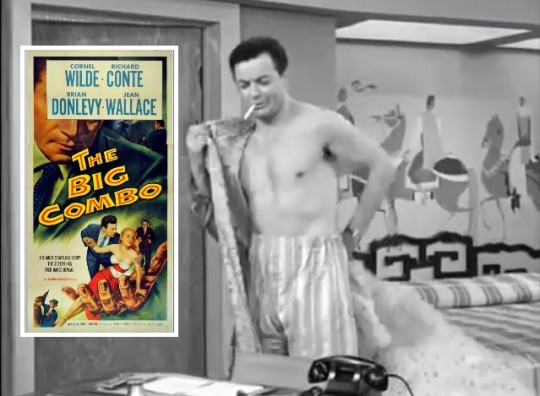
THE BIG COMBO ~ “The Star Upstairs” (1955)
Cornel Wilde promotes his latest film co-starring Richard Conte, Brian Donlevy, and Alan Wallace. Also in the cast were “Lucy” actors Jack Chefe and William Conaty.

A PRIZE OF GOLD ~ “The Tour” (1955)
Richard Widmark promotes his latest film, his first for Columbia Pictures.

CAMILLE ~ “The Dancing Star” (1955)
While singing “How About You” with Van Johnson, Lucy mentions the 1936 film Camille, which starred Greta Garbo and Robert Taylor. Although Taylor never appeared on the series, Lucy claims to have met him at the Farmer’s Market and gotten his autograph on an orange. As for Van Johnson, he appeared with Lucy and Desi in Too Many Girls (1940) and with Ball in Easy To Wed (1946).
There are several other mentions of the film throughout the series, but it is unclear if they are referring to the character from the Dumas fils book and play or the film. This is also true of Gone With The Wind.

CAPTAIN LIGHTFOOT ~ “In Palm Springs” (1955)
Guest star Rock Hudson promotes his latest film co-starring Barbara Rush and Jeff Morrow.

THE SHEIK ~ "The Hedda Hopper Story" (1955)
MRS. MCGILLICUDDY: "Oh, and I must see the house where Rudolph Valentino lived. Oh, I'll never forget him in ‘The Sheik’. (sings) I'm the Sheik of Araby. Your love belongs to me..." LUCY: "You know, they're grooming Ricky to be another Rudolph Valentino." MRS. MCGILLICUDDY: "Ricky? Ricky who?" RICKY: "Ricky me. That's who." MRS. MCGILLICUDDY: "You? (mocking laugh) Why, you're not fit to touch the hem of his bernouse!"

THE IRON PETTICOAT ~ “Lucy and Bob Hope” (1956)
As Hope enters Yankee Stadium, a young fan (David Saber) asks him for an autograph. Before granting it, he asks the boy “Have you seen my latest picture, ‘The Iron Petticoat?’” The boy eagerly replies, “Yes, sir.” However, the film, co-starring Katherine Hepburn, didn't premiere in the USA until early January 1957, three months after this episode aired. It was produced and directed by Ralph and Betty! Not the Ramseys, but Betty Box and Ralph Thomas. Hope had appeared in two films with Lucille Ball, and would do two more.

LIFEBOAT ~ “The Celebrity Next Door” (1957)
Ethel gushes to Tallulah Bankhead that she saw her in Lifeboat (1944).
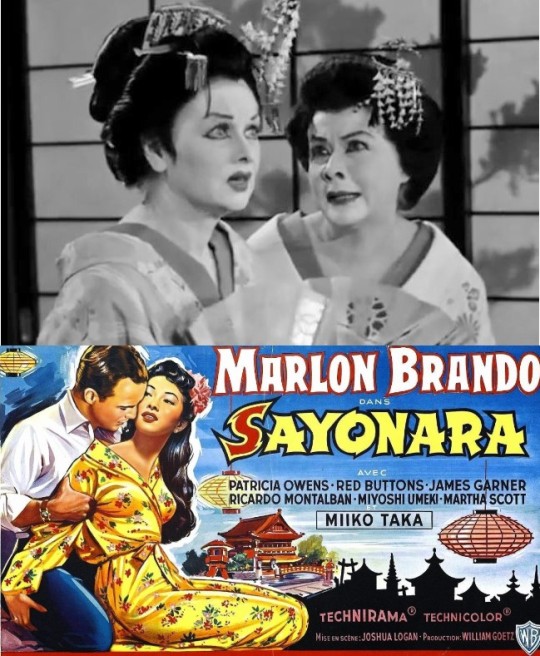
SAYONARA ~ “The Ricardos Go To Japan” (1959)
Trying to be savvy about Japanese customs, Lucy says she sat through Sayonara twice. The 1957 film details a romance between an Air Force pilot (Marlon Brando) and a Japanese woman (Miyoshi Umeki), winning four Oscars.

FOREVER DARLING ~ “Ricky’s European Booking” (1955)
The episode features the Pied Pipers singing the title song from Lucy and Desi’s upcoming fantasy film featuring James Mason.

At the end of the original broadcast of “Bon Voyage”, there was a tag scene to promote the film (and record). Although cut for syndication, the DVD restores this tag scene. Lucy and Desi [or is it Ricky?] are seen sitting in deck chairs.
LUCY: “Did you see the ship’s newspaper? They just raved about your new MGM record of ‘Forever, Darling.’ They said it’s gonna be one of the top records of the year. Let’s get them to play it on the public address system. I know how modest you are, but think what a treat it would be for the passengers.”

SEVEN BRIDES FOR SEVEN BROTHERS ~ “Lucy in the Swiss Alps” (1956)
LUCY: “You remember that picture 'Seven Brides for Seven Brothers'? Somebody shot a pistol and it caused a great, big avalanche.”
After getting trapped by an avalanche, Ethel asks “How'd they get out in 'Seven Brides for Seven Brothers'? Lucy replies that “They waited for the spring thaw!”
~FICTIONAL FILMS~
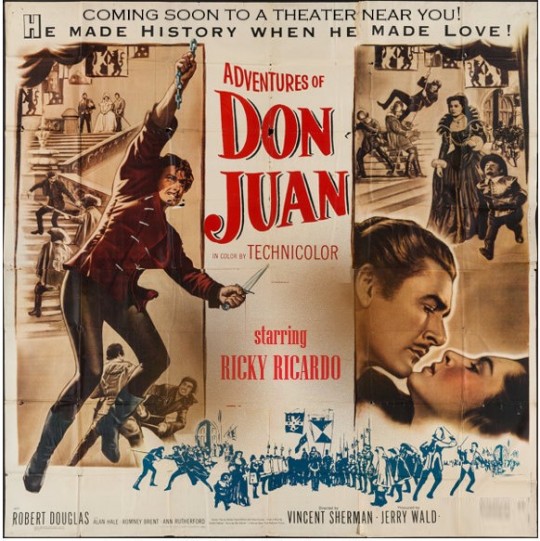
DON JUAN
The film that takes Ricky Ricardo to Hollywood is mentioned in dozens of episodes.
“Don Juan is all about love. It’s got nothing to do with marriage.” ~ “Don Juan and the Starlets” (1955)

SIGNORA LORENZO: “Hark! Do I hear a footfall? Is that you, Don Juan?” DON JUAN: “Yes, it is I, O lovely one. Would that I had the power to tell you what is in my heart tonight.” SIGNORA LORENZO: “What do you mean, my dearest?” DON JUAN: “I have come to say farewell.“ SIGNORA LORENZO: “No, say not so.” DON JUAN: “Would that I could ask you to fly with me, but I know that you’re devoted to your husband, Count Lorenzo.” SIGNORA LORENZO: “Yes, much as I love you, I must stay with him. He is old and feeble and he needs me.” DON JUAN: “But for him, I would sweep you into my arms and carry you over yon garden wall.” SIGNORA LORENZO: “Oh, that I could cut these ties that bind me!” DON JUAN: “Do not cry, my dearest. It was not meant to be. I had no right to win your heart. I had no chance to win your love. So, now, I’m afraid I must say farewell."
Lucy reads that Variety reports that Ricky’s Don Juan is scheduled to have a $3 million budget and be filmed in color. Errol Flynn played Don Juan in Adventures of Don Juan in 1948, which was also in color and budgeted at 3.5 million dollars. Douglas Fairbanks played the character in 1934, and John Barrymore was in a 1926 version that featured a young Hedda Hopper, before she turned to journalism.

MOON OVER BAGHDAD ~ “The Mustache” (1952)
A talent scout (John Brown) is casting a new film called Moon Over Baghdad, an Arabian nights-style Technicolor extravaganza. This is the first time we get a hint of Ricky’s movie aspirations, which will eventually take the foursome to Hollywood in season 4. Through tenuous connections (“My agent has a friend whose brother-in-law knows the talent scout’s wife.”), Ricky, Lucy (beard concealed), and the Mertzes all vie for his consideration. In the final scene, Lucy has finally managed to remove her whiskers and Ricky lands a screen test for the film, although we never hear anything about it again, even when he tests for Don Juan in season 4. There’s also an offer for Lucy.
LUCY: “I don’t care what they pay me. I am not going to play the part of your father!”
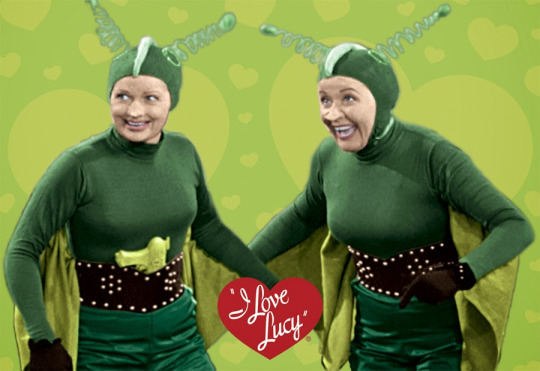
WOMEN FROM MARS ~ “Lucy is Envious” (1953)
Lucy and Ethel make money to fulfill a pledge by doing a stunt for an upcoming film, Women from Mars. The plot was most likely inspired by the 1953 film The War of the Worlds which is also about a Martian invasion. Two days before this episode aired, a British film called Devil Girl from Mars hit US cinemas. Also hitting the big screen in 1953 was Invaders From Mars, which featured Hillary Brooke (“The Fox Hunt”) and Richard Deacon (“The Celebrity Next Door”). America had Martian madness!
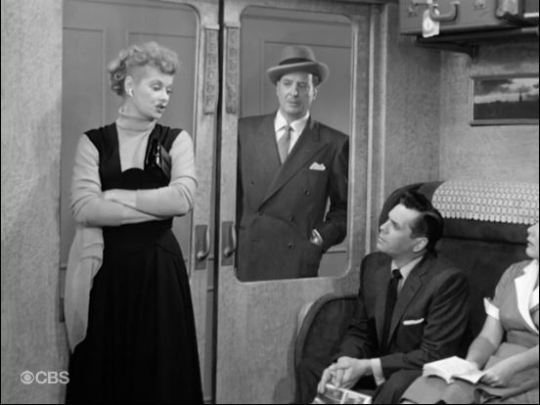
BITTER GRAPES ~ “Lucy’s Italian Movie” (1956)
On the train to Rome, Lucy is eyed by Vittorio Philippi (Franco Corsaro). Taking the title literally, Lucy investigates the wine-making business, leading to one of the funniest scenes in television history as Lucy stomps grapes.

After a tussel in the vat, Lucy proves to ‘blue’ for the role - a typical American tourist - which goes to Ethel instead. Lucy one bitter grape!

TROPICAL RHYTHMS ~ “Home Movies” (1954)
Ricky creates an audition film for a television project. Then Lucy and the Mertzes add their own home movie (a Western) to create a very chaotic film.
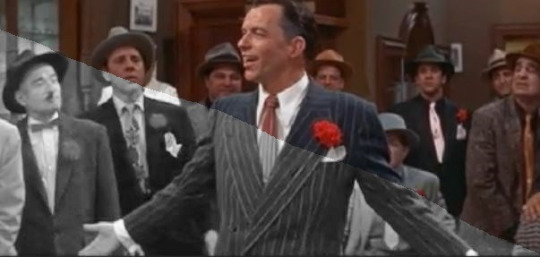
GUYS & DOLLS ~ “Lucy and the Dummy” (1955)
When the episode was running short, a preview clip of the upcoming MGM film musical starring Frank Sinatra was inserted into the Executive Show sequence. After one airing, the sequence was removed and has never been restored. The morning after the original broadcast, fans phoned a bewildered Sinatra to tell him he was on “I Love Lucy” last night - which he knew nothing about!
~UNMENTIONED TITLES~

Un-Titled Florida Project ~ “Desert Island” (1956)
Ricky announces that he’s going to be in a film about the history of the state of Florida. The movie will feature Claude Akins (as a giant native), Joi Lansing and Jil Jarman. Ricky says he will appear in the ‘modern’ scenes playing with his band in the hotel nightclub. In real life, Desi Arnaz got his start in showbusiness in a Florida nightclub.

CLUNY BROWN ~ “The Fox Hunt” (1956)
A few seconds of establishing stock footage of Berkshire Manor was taken from the 1938 Ernst Lubitch film Cluny Brown, which was filmed by 20th Century Fox in a Hollywood studio, but takes place in England. In the film, the home is named Friars Carmel Manor, but with the exception of the lettering bearing the name, the footage is identical.
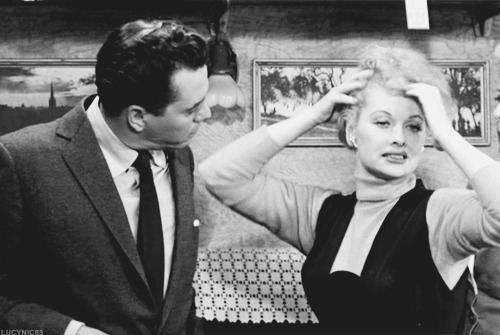
STAGE DOOR ~ “Lucy’s Italian Movie” (1956)
LUCY: “The calla lilies are in bloom again.”
This is a quote from Stage Door (1937), which Lucille Ball always called her ‘big break’. It was Katherine Hepburn’s first line in the play within the film, and was repeated throughout the movie. Ball always admired Hepburn, and it is possible the writers included the line as an homage to her.
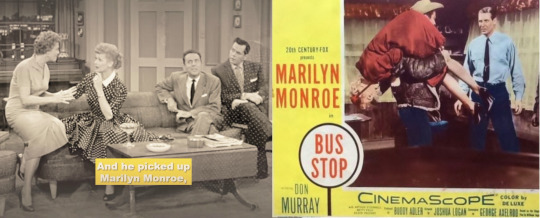
BUS STOP ~ “Lucy and Superman” (1957)
The Appleby’s come over for a social evening. As the scene opens, Caroline is in mid-sentence talking about a film.
CAROLINE: “And he picked up Marilyn Monroe, slung her over his shoulder and carried her off!”
Although the title is never mentioned, the film they are discussing is Bus Stop, starring Marilyn Monroe and Don Murray. It was released in August 1956, two and a half months before this episode was filmed. Frequent “Lucy” character actor Hans Conried has a featured role in the film.

HOW TO MARRY A MILLIONAIRE ~ “Changing the Boys Wardrobe” (1953)
The gang is heading to the movies to see “That picture we’ve been trying to get to for weeks with Marilyn Monroe.” The movie is either Gentlemen Prefer Blondes, which premiered in New York City in July 1953, or How To Marry A Millionaire, which premiered (just in Los Angeles) one day after this episode was filmed.
ETHEL: “Wasn’t that a wonderful dress she had on in the big number?”
Both films were musicals, so this doesn’t narrow it down very much. In either case, it is likely that the title goes unmentioned because Lucy and Desi had just filmed The Long, Long Trailer for MGM Studios and How To Marry a Millionaire and Gentlemen Prefer Blondes were 20th Century Fox pictures.
~FILM INSPIRATIONS~

MURDER AT THE VANITIES ~ “Lucy Gets Into Pictures” (1955)
Lucy finally gets a part as a murdered showgirl in an (un-named) Hollywood movie directed by Ricky’s friend Frank Williams (Lou Krugman). The film may have been inspired by 1934′s Murder at the Vanities, in which Lucille Ball had an uncredited role as a showgirl.

THE MAJOR AND THE MINOR ~ “The Kleptomaniac” (1952)
Under hypnosis (and with a knowing wink to Ethel), Lucy reverts to childhood, with a story and a voice doubtlessly influenced by Ginger Rogers in the 1942 film The Major and the Minor.
LUCY: “It all started when I was a little girl. I was riding on the streetcar one day and I looked up and I saw a box and it said, 'take one.’ So I took one. From then on, I took anything that came into my pretty head even though it didn’t say 'take one.' I took a bright new penny. I took a bicycle. I took a little boy. But my mother made me give him back.

DUCK SOUP ~ “Lucy and Harpo Marx” (1955)
The mirror routine between Lucy and Harpo was first performed by Groucho in Duck Soup (1933). Lucille Ball and Harpo had appeared together in Room Service in 1938 for RKO Studios.

DANCE, GIRL, DANCE ~ “Bullfight Dance” (1955)
The final look for Lucy’s bull costume was no doubt inspired by Ferdinand the Bull, the story of the bull who’d rather pick flowers, than face the picador. The character was integral to the story of Lucille Ball’s 1940 film Dance, Girl, Dance.

GENTLEMEN PREFER BLONDES ~ “Second Honeymoon” (1956)
The plot of this episode very closely follows the adventures of Lorelei Lee (Marilyn Monroe) in the 1953 film Gentlemen Prefer Blondes. In common with this episode and the film is extra Monty O'Grady, who played a passenger on both vessels! Also look for “I Love Lucy” actors Norma Varden (Mrs. Benson in “The Ricardos Change Apartments”), Elliott Reid (Edward Warren from “Face To Face”), and Bennett Green (Desi’s stand-in and veteran background player).
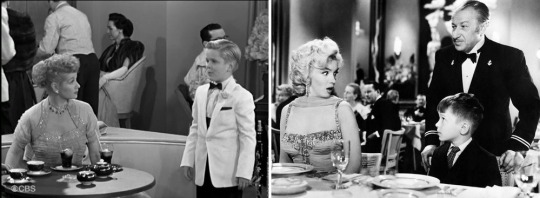
Lorelei’s dinner companion turns out to be a seven year-old boy, just like Lucy’s ping pong partner turns out to be young Kenneth Hamilton played by nine year-old Harvey Grant.
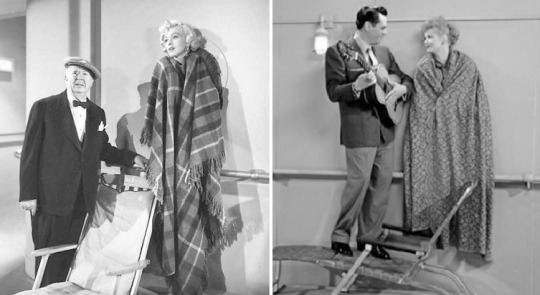
Lucy gets stuck in a porthole just as Lorelei did, also draping a blanket around her shoulders so passersby wouldn’t know what was really going on.
~FILM FUNNIES~

“Ricky Needs an Agent” (1955)
Trying to suggest possible film projects for Ricky, Lucy insert him into the titles of some of Hollywood’s best-known movies:
“Ricky, Son of Flicka” / Thunderhead, Son of Flicka (1945)
“A Streetcar Named Ricardo” / A Streetcar Named Desire (1951)
“Gone With the Cuban Wind” / Gone With the Wind (1939)
“Three Cubans in a Fountain” / Three Coins in the Fountain (1945)
“It Happened One Noche” / It Happened One Night (1934)
“Seven Brides for Seven Cubans” / Seven Brides for Seven Brothers (1954)
“Meet Me in St. Ricky” / Meet Me in St. Louis (1944)
“The Ricardos of Wimpole Street” / The Barretts of Wimpole Street (1957)
“Andy Hardy Meets the Conga Player” / Andy Hardy Meets Debutante (1940)
“Arsenic and Old Ricky” / Arsenic and Old Lace (1944)
#I Love Lucy#Lucille Ball#desi arnaz#William Frawley#Vivian Vance#Movies#Films#Richard Widmark#William Holden#Van Johnson#Rock Hudson#John Wayne#Tallulah Bankhead#Bob Hope#Cornel Wilde#TV
4 notes
·
View notes
Photo

Rita Hayworth displays The Rudolph Valentino Prize statuette she was awarded for her role in “Career Excellence” along with Glenn Ford, 1978
102 notes
·
View notes
Photo
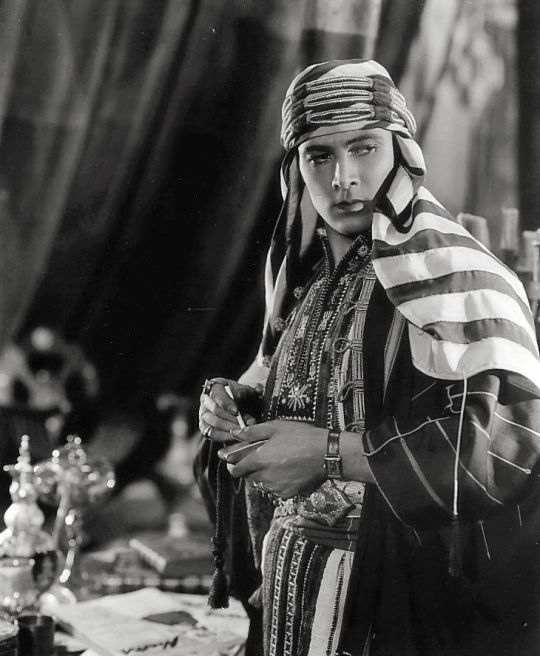
Rudolph Valentino wearing his prized Cartier Tank watch in the 1926 film, “The Son of The Sheik.”
#rudolph valentino#the shiek#vintage#vintage watches#wristwatches#old hollywood#cartier#cartier watch#vintage hollywood#timepiece#vintage timepiece#men's fashion#men's vintage fashion#vintage fashion
337 notes
·
View notes
Text
All-time fav SteveTony smut fics
Today is fanfic writer appreciation day so I want to send lots of love to all the amazing authors out there who share their work with fandom. Every one of you rocks! To celebrate, I thought I’d do an all-time favs rec list for that sweet smutty Steve/Tony goodness. All of these fics are rated explicit so get out your smut-reading poker face and enjoy!
Also, please leave comments and kudos to thank our wonderful authors for all of their hard work <3
Love Across the Multiverse by Sineala @sineala (16k, Ults)
Mojo presents: Love Across the Multiverse! In tonight's episode, a battle-hardened supersoldier finds himself drawn to his handsome, genius teammate! It's an agonizing duel between his long-held beliefs and the secret passions of his heart! Will true love conquer all? There's only one way to find out! Don't miss the highlight of the season!
Crash Love by S_Hylor (21k, Ults)
It’s just sex. Just sex between two consenting adults who don’t have feelings for each other beyond the camaraderie that comes from being on the same team.
It’s just sex. Until it isn’t. It’s not love. Until it is.
Sotto Voce by Woad (3k, Ults)
Tony's motto is better to give than to receive. With Steve, that's a must.
Just a Whisper by blue_jack (2k, MCU)
Tony’s always had a little voyeuristic streak in him.
Tomorrow It's Ransom... or Torture! by Muccamukk (3k, MA:A)
Tony's thinking dirty thoughts, unfortunately they're not quite dirty enough for Steve. Or, the time Steve talked Tony into playing Rudolph Valentino to his Vilma Bánky and getting a little afternoon ravishing in.
Heat by gracerene (2k, MCU)
Steve and Tony share a bed and end up getting more than they'd bargained for.
Good Game by 51stCenturyFox (2k, MCU)
Steve had an ass like...it could make Tony write sonnets if he did that sort of thing, he was sure. Really bad ones, with phrases like "unyielding spheres of rapture," so it was a good thing he's no poet.
love the sin, love the sinner by silkspectred @silkspectred (10k, MCU)
It keeps happening. Not often, just once or twice a month, but it keeps happening. Always in the same way: it’s unplanned, sudden, unexpected, Steve is surprised and eager, his dick goes from zero to one hundred in two seconds, Tony’s touch is electric, everything he does drives Steve crazy, but he never lets Steve kiss him, he very rarely looks Steve in the eye, he never talks, never makes a sound when he comes, never mentions it later.
Blink by kaesaria (6k, MCU)
The one where Steve learns that you should never bet against Tony—not unless you’re ready to face the dirty dire consequences of losing. Or... maybe it’s the other way around?
Backhand by Sineala @sineala (2k, 616)
Tony always knows what Steve needs, even before Steve does. But just because Steve needs something doesn't mean he likes needing it -- especially when what he needs is to hit Tony.
ties that bind by CapnShellhead @capn-shellhead (4k, 616)
Captain America gets kidnapped and Tony finds him in quite a state.
Steve Rogers Never Was a Boy Scout by ifitwasribald (29k, MCU)
Shameless smut. I regret nothing.
Give Up The Ghost by foldingcranes @foldingcranes (1k, 616)
Director Stark gets a late night visit.
The Prize by sabrecmc @sabrecmc (160k, MCU AU)
Steve ends up as a concubine in the royal harem.
Mark XXX by Robin_tCJ (4k, MCU)
Oh, look, another filthy, filthy threesome porn. This time, it's Steve/Tony/Iron Man Armour. No plot, mostly porn with a little bit of cracky humour. It's dirty, and I'm sorry.
No I'm not. I'm not sorry. You know what, you're all down here in the muck with me.
Take It Like You Mean It by Amuly (9k, 616)
Steve Rogers is new to the Avengers and fitting in just fine. At least, he seems to be, though Tony notices that after battles he has a certain itch that needs scratching... in his ass. Soon enough, Tony finds himself watching as Steve fucks his way steadily through various teammates: Namor, Thor, Sam, Clint (or, more accurately, is fucked by them).
To Tony's great frustration, Steve never seems to ask Iron Man, or Tony Stark (because for all Steve Rogers knows, they're two different people) for a helping hand. It's enough to make a guy feel unwanted!
Wild Ride by coaster @coastertoaster (3k, 1872)
Tony is the damsel tied to the rails and Sheriff Steve Rogers is here to save him.
Sheriff Steve Rogers is here to ravish him.
Masked and Anonymous by panickyintheuk @shiningredandgold (4k, 616)
"When Mr. Stark opened the door, he had his shirt untucked, and no shoes on. It was evening, and it was his own apartment, and Steve was dropping by unannounced, so that was all really fair enough, but it was also the least put-together Steve had ever seen him."
Steve drops in on Avengers benefactor Mr. Stark, but it seems that Mr. Stark was expecting him.
Good, Better, Best by msermesth @msermesth (2k, Ults)
Steve has a little alone time.
The Ruins of Babel by WhenasInSilks @whenas-in-silks (7k, MCU)
Steve struggles to find a language in which he and Tony can still communicate.
(aka, the story of three phone calls, a smutty character study in seven shades of pining. Also there is angry phone sex. Part of a series.)
A Hundred Times, Once by FestiveFerret, SirSapling @festiveferret @sirsapling (25k, Ults)
The shrill tone of his SHIELD beeper pulls Steve out of sleep and into battle. He fights robots, he fights Tony's shameless advances, he fights the exhaustion that threatens to take over him, drown him. And then the next morning, he wakes and does it again. Exactly the same.
And again.
And again.
And again.
Pay in Kind by Arukou @arukou-arukou (2k, 616)
Iron Man knows Steve doesn't blame him for the mind control, but he can't help wanting to make it up anyway.
Oxidation by paxnirvana (10k, Ults)
Terrorists develop a riot-inducing spray that has unexpected effects on America's only Super Soldier.
468 notes
·
View notes
Text
It’s 1919, 100 years ago this year. The U.S. President is Woodrow Wilson. The world population is about 4.4 billion. The cost of a first-class stamp rises mid-year from 2¢ to 3¢. Two pounds of roast beef costs about 38¢ and the most popular work of fiction is The Four Horseman of the Apocalypse by Vicente Blasco Ibáñez and the Pulitzer Prize for fiction goes to Booth Tarkington’s The Magnificent Ambersons. Former President, Theodore Roosevelt dies in his sleep at the age of 60 in January and the Influenza Pandemic rages on, killing more people in one year than during the four years of the black plague.
1919 is the year during which Major League Baseball suffers the worst scandal in the game’s history when nine players from the Chicago White Sox throw the World Series against the Cincinnati Reds. In a positive baseball light, 1919 is the year when Babe Ruth is sold by the Boston Red Sox to the New York Yankees for $125,000, the largest sum ever paid for a player at that time. The deal was announced on January 6, 1920.
The year sees the end of World War I with the signing of the Treaty of Versailles. The US Congress approves the 19th Amendment to the United States Constitution, which guaranteed voting for women, and sent it to the individual states for ratification. January of that year also brings the ratification of the 18th Amendment to take effect the following year.

Dial telephones were introduced by the American Telephone and Telegraph Company in 1919. Numerous important Broadway shows opened that year. You can take a look at the list at Broadway World. And then there were movies by what was by that time a robust industry. Here’s to them and the players who made them possible.
Celebrating a 100th Anniversary
The Movies
Top Grossing Films of 1919:
1. George Loane Tucker‘s The Miracle Man 2. Marshall Neilan‘s Daddy-Long-Legs 3. Ernst Lubitsch‘s Madame DuBarry 4. James Cruze‘s The Roaring Road 5. Victor Fleming‘s When the Clouds Roll By 6. James Cruze’s Hawthorne of the U.S.A. 7. D.W. Griffith‘s Broken Blossoms 8. Cecil B. DeMille‘s Male and Female
A gallery of some of the notable films released in 1919:
This slideshow requires JavaScript.
The People
Listen to the top songs of 1919 here. Among the notables who had hits in 1919 are Al Jolson, Eddie Cantor, Bert Williams, and the Louisiana Five.
Popular Movie Stars:
Dorothy Gish
Pauline Frederick
Gloria Swanson
Douglas Fairbanks
Mary Pickford
Charlie Chaplin
Harold Lloyd
Roscoe Arbuckle
Rudolph Valentino
Lillian Gish
Harry Houdini
Lon Chaney
Tom Mix
You may recognize some of the famous faces born in 1919…
This slideshow requires JavaScript.
The Debuts
Several would-be legends made their debut in 1919. Among them…
Boris Karloff in George B. Seitz‘s The Lightning Raider
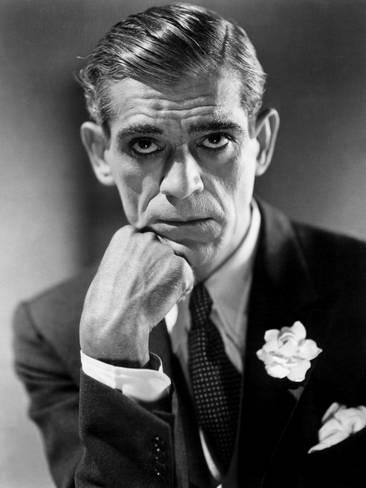
Fritz Lang directed his first film, Halbblut

Vilma Bánky in Carl Boese‘s Im letzten Augenblick
Shemp Howard in Spring Fever (short)

Norma Shearer uncredited in Larry Semon’s The Star Boarder (short)
Oscar Micheaux became the first African-American to produce and direct a feature film when The Homesteader, starring pioneering Evelyn Preer, was released in 1919

Claire Windsor in Albert Parker‘s Eyes of Youth (uncredited)
Anna May Wong uncredited in Albert Capellani‘s The Red Lantern
Erich von Stroheim made his directorial debut with his own script for the film Blind Husbands released in 1919, a film in which he also starred as Lieutenant Eric Von Steuben.
Movie Happenings
A few of the significant movie-related events of 1919…
Charlie Chaplin, D. W. Griffith, Douglas Fairbanks Sr., and Mary Pickford established United Artists.
Charlie Chaplin begins work on The Kid, his first feature film. His co-star will be four-year-old Jackie Coogan.
The Barney Google cartoon strip, by Billy DeBeck, premiered. Originally Take Barney Google, F’rinstance, Barney was later joined by Snuffy smith.

Harold Lloyd suffered a serious accident while taking some publicity photos for his new series of two-reelers. He lit what he thought was a prop fuse bomb and posed with it when it went off. The accident resulted in his losing a thumb and index finger. Lloyd returned to the screen, however, as one of film history’s most daring actors.
United Artists’ first feature film, the comedy His Majesty, the American, premiered. Directed by Joseph Henabery the film starred one of the studio’s founders, Douglas Fairbanks.
Walt Disney teamed with Ub Iwerks to form Iwerks-Disney Commercial Artists (later known as Ub Iwerks), to create cartoon animations.
Max and Dave Fleischer‘s Out of the Inkwell series premiered, introducing KoKo the Clown, one of the first animated characters.
Felix the Cat first made his debut in Feline Follies
Rudolph Valentino married Jean Acker. The union lasted approximate six hours.

Valentino and Acker
Richard Rodgers and Lorenz Hart begin their professional songwriting partnership.
The “Ziegfeld Follies of 1919,” the most lavish edition to date, includes the Irving Berlin song “A Pretty Girl Is Like a Melody.”
George Gershwin writes “Swanee” with Irving Caesar and Buddy DeSylva and Al Jolson’s 1920 recording of the song sells two million copies.
Actors’ Equity is formed after striking actors, stagehands, and musicians bring Broadway to a halt for a month (August to September).
George Gershwin debuts his first full Broadway musicall, La, La, Lucille

Radio Corporation of America (RCA) is founded.
Harold Hamgravy, longtime boyfriend of Popeye’s Olive Oil, made his debut in Thimble Theatre Comics.
◊
I hope you enjoyed this trip down memory lane and the centenary of 1919. I’ll be back in short order with other significant anniversaries for 2019.
1919 Centenary or 100 Years Ago in the Movies It's 1919, 100 years ago this year. The U.S. President is Woodrow Wilson. The world population is about 4.4 billion.
23 notes
·
View notes
Text
Badly Behaved Sheikhs: the Intro
Let’s kickstart this blog with an easy target - sheikh romances.
Ever since Rudolph Valentino rode across screens in 1921 as the eponymous sheikh (who, we later discover, isn’t even Arab at all, the bloody fraud) who kidnaps a white woman and forces her to love him, Sheikhs have occupied a special and incredibly unedifying space in Western romantic literature.
The Sheikh is rich, domineering, and probably Western-educated. His robes are white and glowing. His name is a mish-mash of random syllables, some of which contain sounds that don’t actually exist in Arabic. His prize is inevitably white and so much more spirited and interesting than boring submissive Arab women because, as we all know, Arab men = sexually aggressive savages, Arab women = basically potato sacks with eyes.
Anyway, enough of that brings me onto today’s book, which has possibly one of the least sexy central concepts I’ve ever come across:

A Real-Live Sheikh by Jacqueline Diamond - Google Book Preview
Let’s just dive straight in...

Let’s be clear - this made my vagina shrivel up, and I don’t think it’s coming back. There are entire international organisations dedicated to stopping what this man is trying to do.
Anyway, Kedar Bahram immediately falls for Cathy, and her defiant cheese-shaped hair:

Several pages in, we discover he wears ‘clothes’ (which I presume means western clothes) under his thobe. Because that is totally normal. Personally I wear three piece suit underneath everything I wear at all times:

Cathy, of course, does not realise how weird this is because her independent blond wedge-shaped American spirit knows nothing of the mysterious East:

What’s that sound? It’s Edward Said, allah yerhamo, spinning so hard in his grave he tunnels through the Earth and smacks the keyboard out of Jacqueline Diamond’s hands.
Anyway, as luck would have it, Cathy is also attracted to the exotic smelling paedophile trying to marry her toddler:

At this point, both my patience and my free preview ran out.
59 notes
·
View notes
Text
info dump - michael/pre-pact
pretty long so you dont have to read
tldr - son of hades, born in 1915, died in 1933, one of hades’s assistants, pretty much everything else re: characterization is the same
Timeline
Born in Los Angeles in 1915 to two Italian immigrants - Paolo and Giuliana Mancuso. He is the last of four children. He has three older brothers - Gabriel, Roberto, and Giacobbe (Gabe, Bobby, and Jake).
His real father was Hades, unbeknownst to Paolo. Paolo was regularly abusive to his wife and kids, so Giuliana would never even consider telling him the truth.
His was born female, but identified with his masculinity from an early age. He grew up very Roman Catholic and was forced to take on gender roles he was very uncomfortable with. His birthname was Angela Mancuso.
He grew up very poor. His father was a laborer and his mother worked in the garment industry. His brothers also were laborers as soon as they were old enough and Michael dropped out of school and “worked in a garment factory” (explained a few bullet points below) when he was thirteen.
Michael acted out often as a child by defying the roles he was expected to play. He often got in fights at school, wore his brothers’ clothing, and repeatedly cut all of his hair off. Each instance resulted in severe punishment.
Starting when he was twelve, he boxed on the street as coping mechanism. This also helped him earn money, as people would often throw coins into the ring in the alleyway. He soon leads something of a double life, as his parents believed he was going to work at a garment factory as Angela, but he was actually boxing in amateur fights for prize money under the name “Mike Valentino.” He chose the name Michael after the archangel Michael, his favorite biblical figure, and Valentino after the actor Rudolph Valentino, an actor whose masculinity he admired.
He made himself look masculine by exercising vigorously, specifically targeting specific areas to make his shoulders broader and his chest smaller. He cuts his hair short (something his family is not happy about) and slicks it back when presenting as a male. He’s lucky that his features are already androgynous and that he’s almost six feet tall. Passing is pretty easy for him.
When he’s fourteen, he comes home from a fight to find his father beating his mother. It comes to light that Paolo is not Michael’s father. Michael attempts to stop Paolo from hitting his mother and Paolo turns on him. He hits Michael in the face and yells a string of verbal abuses that bring Michael to his breaking point. Michael beats his father unconscious and flees the apartment, unsure if he’s killed him or not. He uses his connections through boxing to find a job in the criminal underbelly of the city, working as a Mafia soldier, mainly used for intimidation purposes. His transsexual identity is not known by anyone but himself and he is known as Michael or Mike for all purposes.
Michael doesn’t fight again until he’s seventeen, in 1932. He becomes a semi-prominent figure in the middleweight class (a class he just barely made the cut of) and he starts to rise slowly in the ranks of the Mafia. He earns more respect, more money, and more power. Michael’s moral code and ethics have always been most important to him, and the increase in power starts to test that.
An enemy of Michael discovers that he’s genetically female and threatens to out him when he’s eighteen. The man stabs Michael in the stomach with a weird looking dagger and Michael beats him to a pulp. When the man bleeds golden blood (he was actually Kratos, sent by Zeus to intimidate Hades’s children), Michael panics and flees the city. He bleeds out and dies somewhere in Pennsylvania. He dies in 1933.
Upon reaching the Underworld, he is sent to Hades’s palace, who offers him a proposal. He stays in the underworld, or he becomes one of Hades’s assistants. The world was becoming a more dangerous place with fascism spreading and war approaching, and Hades had conscripted a few of his children to help him. In exchange for serving him, Hades offers him pendant of Heracles, made of Stygian Iron and supposedly dipped in Heracles’ blood, which he promises will “turn his blood to that of men” (aka raise his testosterone levels). Michael accepts. He wears the coin on a chain around his neck under his shirt at all times.
He mostly surveys battlegrounds and helps Charon out for the majority of the 20th century. World War II is extremely busy, and it gets sporadically busy every couple years after that until the end of the twentieth century. Into the 21st century, it’s rare for Michael to leave the underworld. He’s usually just doing Hades’s busywork around his palace or helping out in other ways around the Underworld.
During the Second Titan War, he’s sent by Hades to help out Camp Half-Blood and do damage control.
When the Doors of Death are opened by Gaea, Michael is sent back out again to wrangle up escaped monsters and souls.
Some non-timeline headcanons
While out of the underworld, Michael shadow travels and drives a motorcycle. The motorcycle is kind of unnecessary with the shadow-traveling but Michael thinks it’s really cool.
Michael and Nico have a weird begrudging relationship. When they first meet, it comes up that it seems like Hades has a thing for Italian girls, which makes them both uncomfortable. Neither of them remember who brings it up, but it’s weird. They both have a room at Hades’s palace and run into each other all the time. They usually just stand next to each other and don’t talk. Michael always feels like people are comparing them because they look like full-blooded brothers, and he’s pretty sure Nico feels the same way.
Michael starts what’s essentially a fight club in the Fields of Asphodel.
#michael valentino#idk i like this? i've been toying with my hades kid ideas for years now but i feel like i've landed on something good#also i've been thinking about historical transgenderism for a while i love history#anyways here
6 notes
·
View notes
Text
How John Dos Passos Left the Left
The reputations of the writers who transformed literature during the Jazz Age, the so-called “Lost Generation,” have undergone some interesting up and downs. Theodore Dreiser and Sinclair Lewis have largely disappeared from the canon. Dreiser’s sludge-like prose doomed him among readers over the last half century, while Lewis, who achieved fame in the ‘20s, becoming the first American to win a Nobel Prize for Literature in 1930, has seen his reputation sag. None of his indictments of middle-class America have found an audience today. Good luck trying to get a class of college sophomores to read Main Street. His last real success, It Can’t Happen Here (1937), had a brief revival with the election of Donald Trump. But no one reads Babbitt or Elmer Gantry anymore.
Hemingway’s name remains popular, though it is doubtful whether any of his novels are read today, other than The Old Man and the Sea, which is popular, I understand, in seventh- and eighth-grade language arts courses (precisely where it belongs with its faux-biblical prose). During the virus, I picked up The Sun Also Rises, which I’d first read in college and thought a fresh and wonderful book. Now it seemed shallow. Even the dialogue, which I thought so smart, sounded old hat. Lady Brett came off as an adolescent’s dream of what sex could be like with an ever-willing woman. If Hemingway is read today, it’s not for his novels but his short stories, which, at their best in “Hills Like White Elephants” and “Big Two Hearted River,” remain sharp, hard-edged gems.
Scott Fitzgerald faired best of the ‘20s generation. The Great Gatsby, the most popular of his novels, may be The Great American Novel of the 20th century. It captures young readers of every generation.
But what of my personal favorite as a young man, John Dos Passos? Rereading him amid this terrible virus, I believe he holds up best.
During the 1930s, Dos Passos was as popular as any writer of serious fiction in America. He had made his breakthrough after World War I during which he served in the ambulance corps. Two of his novels, Three Solders (1921) and Manhattan Transfer (1925), “changed the whole tone of opinion about the war,” as H.L. Mencken put it. They reflected the attitude, also popular in England at the time, that the war was a worthless conflict imposed by heartless leaders that had wiped out a generation of young men. But unlike Hemingway, Fitzgerald did not romanticize Europe and flee to Paris. In his view, America was all about the rejection of Europe.
Like Lewis and Hemingway, Fitzgerald was disgusted by the materialism and money grubbing of the America of Harding, Coolidge, and Hoover. He supported various left-wing and radical causes and became particularly incensed over the treatment of Sacco and Vanzetti, the two anarchists accused of murdering a guard during a Braintree, Massachusetts, payroll robbery. His epitaph on the case summed up what it meant to radicals and revolutionaries of his generation: “All right we are two nations.”
Following Three Soldiers and Manhattan Transfer, Dos Passos moved deeper into radicalism. He denounced Franklin Roosevelt and voted for the Communist candidate, William Foster, in the 1932 presidential election. He dismissed the New Deal for trying to save a corrupt capitalist system. The depression pushed him further to the left. For a time in the 1930s, he was associated with the communist journal New Masses, though he never joined the Communist Party and wasn’t even much of a fellow traveler. In truth, Dos Passos was an idiosyncratic man of the left.
Out of his anger, Dos Passos produced his greatest and most original work, the trilogy U.S.A., which appeared between 1930 and 1936. U.S.A. is a big sprawling book of around 1,200 pages and his most original and influential work. Building on some of the anti-capitalist themes he first outlined in Manhattan Transfer, Dos Passos set out to paint a broad picture of America in turmoil. He used techniques borrowed from European modernists like James Joyce in a way no American author ever had before to create a new reality. He sprinkled his text with brief biographies of famous and not so famous people: Rudolph Valentino, Thorstein Veblen, Presidents Teddy Roosevelt and Woodrow Wilson (a b��te noire of his), and Henry Ford, among others. In the “Camera Eye” sections, he created news items from a pastiche of newspaper headlines and stories. The effect was to give the novel an immediacy and sense of dealing with the real world. The technique has been copied since, but no one has done it as well.
U.S.A. was a huge success and appeared just as Dos Passos’ career took a dramatic turn. In July 1936, the Spanish Civil War broke out. Dos Passos, like many of his fellow leftist contemporaries, most notably Ernest Hemingway, was drawn into the conflict. He went to Spain to work on a documentary film, “Spanish Earth,” designed to promote the cause of the Republican forces. Disillusion soon set in. One of his friends, José Robles Pazos, was caught up in the fighting among the various leftist factions and murdered by the communist secret police.
Like his contemporary George Orwell, Spain inaugurated Dos Passos’s distrust of communism and its fellow travelers and apologists. His consequent drift to the right was rooted in one of the abiding themes of his career—a deep distrust of power, especially power in the hands of an elite. Fear of unregulated capitalism and fascism now gave way to a conviction that the greatest threat to democracy was communist power. World War II furthered these concerns, with Dos Passos increasingly troubled by the power exercised by FDR during the war.
Dos Passos continued writing fiction and in 1962 published Mid-Century, a follow-up to U.S.A., only now the villains were on the left—especially labor leaders like John L. Lewis and Walter Reuther. Mid-Century lacked the creativity of his trilogy. Instead of the “Camera Eye” and other unusual techniques that seemed fresh in the 1930s, Mid-Century featured long documentary sections interspersed among the text. The book was a success, but the critics accused him of turning his back on his past. Dwight Macdonald, a former admirer and firm man of the left, wrote that Dos Passos had become “a simple Republican, scared to death of Russia and Communism.”
The man who once had written for the New Masses now became a contributor to Bill Buckley’s National Review. He came to view the American experiment through different eyes, even writing a highly sympathetic history of the Founding Fathers. In 1964, Dos Passos supported Barry Goldwater’s campaign for president. That shocked many of his admirers but was a natural outcome of his drift to the right that had begun in Spain. Both men feared communism and unrestrained power. In the 1920s, that power was in the hands of big business; now it was found in big government and what President Eisenhower called “the military-industrial complex.”
Maybe Dos Passos’ journey wasn’t that strange after all.
John P. Rossi is professor emeritus of History at La Salle University in Philadelphia.
The post How John Dos Passos Left the Left appeared first on The American Conservative.
0 notes
Text
Musso and Frank Grill: Over 100 Years in Hollywood

Not many businesses, let alone restaurants, can say they have been in business for over 100 years. Not many restaurants can say that members of the founding families still operate them today. Nor can many say their old school continental steakhouse entrees (flannel cakes, chicken pot pie, Welsh rarebit) that have been on the menu since the restaurant first opened, still draw patrons who pine for a fix if they’ve been absent too long. Few can claim there have only been three executive chefs in their entire history, or that the first one (Jean Rue) stayed for 53 years. Nor can they say that their headwaiter (Jesse Chavez), who began as a busboy in the 1920s, later became part owner for a time. Or that a bartender like Manny Aguirre could literally make your day better with his classic gin martini (stirred with ice) and legendary smile. But Musso and Frank most certainly can.
Firmin “Frank” Toulet opened Fran’s Café on September 27, 1919 at 6669 Hollywood Boulevard. To put this in perspective: the motion picture industry had barely been in town ten years; WWI had just concluded; there was a nationwide pandemic known as the “Spanish flu” still sweeping the nation; and Hollywood Boulevard was a mixture of Victorian mansions and brick storefronts. Toulet later changed the name to Frank’s Francois Café, and when he partnered with Joseph Musso in 1923, renamed it Musso and Frank Grill. Four years later, the restaurant changed into the hands of John Mosso and Joseph Carissimi, a team who operated other restaurants in Portland, Oregon and Sacramento, California.
The original room, a dark paneled dining space with a long counter and open grill on one side, housed red leather booths for maximum privacy on the other. One of the first public telephone booths on the Boulevard was at the rear. By 1936, the restaurant had expanded to include a private “back room” and moved its front door to 6667 Hollywood Boulevard. Expanding again in 1955 (when it took over the space occupied by the Stanley Rose Bookstore to the east), the “new room” was added, creating the configuration that patrons are familiar with today. That room now contains the same ornate bar, fixtures, and furniture from the “back room” and little has changed in six decades.

The restaurant grew alongside the burgeoning film industry and was also a favorite haunt of literary icons and other artistic patrons from the get go. Beginning with Charlie Chaplin, who reportedly loved the roast lamb kidneys and always occupied a corner booth, Musso’s served all the movie stars and moguls including Greta Garbo, the Warner Brothers, Pickford and Fairbanks, Rudolph Valentino, Bette Davis, Humphrey Bogart, Claudette Colbert, Edward G. Robinson, and Orson Welles, to name a few. The business community joined them, represented by developer Charles E. Toberman, who lunched there well into his 100s, and regularly brought his family for dinner. With the Screen Writers Guild conveniently located across the street, and Stanley Rose Bookstore right next store, it was a natural home base for Hollywood’s literati transplants, especially those from the East Coast, seeking a familiar New York style atmosphere. California’s preeminent historians Carey McWilliams and Kenneth Starr chronicled their visits, with Starr saying that the list of authors who dined there was “the list of required reading for a sophomore survey of the mid-20th century American novel.” Legendary wordsmiths like William Faulkner, William Saroyan, Nathanael West, Dorothy Parker, Dashiell Hammett, F. Scott Fitzgerald, Thomas Wolfe, and Ernest Hemingway were recruited by the studios to write screenplays in the hopes their fame would sell tickets. They prized Musso’s ambience and as such, the restaurant made cameos in their work, with quintessential set and setting descriptions of its scene appearing in Nathanael West’s Day of the Locusts and Bud Schulberg’s What Makes Sammy Run?
Guided by generations of Carissimis and Mossos, Musso’s has been a constant in the ever-changing landscape of the Boulevard. New generations of celebrity patrons including Johnny Depp, George Clooney, Brad Pitt, and Keith Richards have sung the restaurant’s praises, keeping Musso’s legendary status intact and visits to it, a traditional right of passage for anyone worth their salt in Hollywood. It has starred in movies and television shows like Ocean’s Eleven, Mad Men, and of course, Once Upon A Time in Hollywood. Just as important, it is a community treasure, beloved by residents and visitors alike. For the price of one of those martinis, an order of flannel cakes or filet of sanddabs, you too can step back in time and be part of Hollywood history, still. Cheers to another 100 years...
~ Christy McAvoy, Historic Hollywood Photographs
Sources: Bruce Torrence archives; Musso and Frank Grill website; The Dream Endures by Kevin Starr

#historic hollywood photographs#hollywood#hollywood blvd#musso and frank#restaurants#bars#history#centenarian#musso & frank's
0 notes
Text
Top 12 Ramp Cars from the 2017 Pebble Beach Concours d’Elegance
Pebble Beach’s 2017 Concours d’Elegance is in the rearview mirror and we’re still looking back. At what? Everything from huge touring automobiles to oddball specials from the 1960s to Cobras and race cars more than 100 years old. Plus, of course, a magnificent field a Ferraris.
We chose a dozen we think represent the depth and variety of ramp cars, the vehicles that earned a trip in front of the enthusiastic crowd.
1. 1929 Mercedes-Benz S Barker Tourer
Less than a week out of its restoration shop, Bruce McCaw’s Mercedes took the top prize—Best of Show—at the 2017 Pebble Beach Concours. Fitted with a body by Barker in England, the S is actually at SS specs with a supercharged 7.0-liter engine. We’re giving you a twofer on images because you need to see both the long polished hood and boattail rear of this spectacular Mercedes, plus the lights, horns and grille up front. And guess who McCaw beat for Best of Show? His brother John, whose 1957 Ferrari 315 S Scaglietti Spyder was one of the other three finalists for BofS.
2. 1949 Ferrari 166 MM Touring Barchetta
This is a repeat from our earlier Ferrari story, but it is arguably the most important car in that automaker’s history. First there’s the beauty of the Touring body shaped by Carlo Felice Bianchi Anderloni (ever wish your name was that long and regal?). Under the front is the famed Ferrari 2.0-liter V-12. Nicknamed “Barchetta” or little boat, these early Ferraris established the company’s reputation as a winner. None more so than this one, chassis 0008M; it won two of the toughest races in the world, the Mille Miglia and the 24 Hours of Le Mans in 1949.
3. 1904 Renault AI 35/45 HP Vanderbilt Racer
Okay, it isn’t on the ramp, but it would be for three awards. Here seen arriving during the Dawn Patrol is Rob Kauffman’s 1907 Renault AI 35/45 HP Vanderbilt Racer. It would win the Phil Hill trophy, the Revs Program at Stanford award, and its class for open-wheel race cars. These highly prized and priced Renaults—a nice one is easily more than $1 million—got their nickname because they were linked to “Willie K.” Vanderbilt, one of the better-known and financed auto racing enthusiasts of the early 1900s.
4. 1955 Alfa Romeo 1900CSS Boano Coupé Speciale
There’s something very mid-1950s about this car, which was built for the 1955 Turin Show by Carrozzeria Boano. It might be a basic shape, which reminds a bit of the Alfa Disco Volante race cars, or maybe that yellow. And why the arms waving from inside? This Alfa just won the Postwar Closed class.
5. 1969 Pontiac Vivant Herb Adams Roadster
Many of us knew Herb Adams back in the 1970s as the most innovate engineer at Pontiac. In my Motor Trend days, we followed his Grey Ghost 1964 Pontiac Tempest Trans-Am car. At the same time, Adams was creating complete automobiles, like the Pontiac-based Vivant Roadster. He built the space frame chassis over which three Italians metal shapers formed the sleek body. Power is from a 370-cubic-inch Pontiac V-8. Adam’s Vivant won the American Dream Cars of the 1960s class.
6. 1932 Isotta Fraschini Tipo 8A SS Castagna Commodore
Pebble Beach honored Isotta Fraschini this year and had three classes for the big machines. All had distinctive stone guards for the radiators and we particularly liked this one. If you look closely, you might see the cobra mascot atop the radiator. This was first designed to promote the Rudolph Valentino movie, Cobra. This type 8A Isotta has a “Commodore” body by Castagna. Owned by the Atwell family from Buda, Texas, it has now been shown at Pebble by three generations of the family.
7. 1960 Abarth 1000 Record Pininfarina Prototype
Imagine this: hitting a top speed of 136 mph with just a tiny 982-cc Fiat engine. Yet that’s the result of Abarth teaming with Pininfarina to create this super slick record car. Nicknamed “La Principessa” by its team drivers, it set eight international class G speed records in 1960. The body was tuned in the Turin University wind tunnel and made of lightweight, ultrathin Peraluman. Quite the contrast to the next racing car on our list.
8. 1931 Bentley 8 Litre Vanden Plas Tourer
Can’t you just imagine what it would be like to drive this Bentley over the ramp at Pebble and then rush off on to 17 Mile Drive? Winner of the Prewar Preservation class, it is just one of 100 of the 8-liter Bentleys. Vanden Plas spent a year creating the race car body for this example.
9. 1948 Isotta Fraschini Tipo 8C Monterosa Boneschi Cabriolet from Milan, Italy
To go along with having possibly the longest name on the judging field is that long tail on this Isotta. This was one of a series of cars meant to restore the automaker after the war, an effort that failed due in part to the Isottas’ cost, some $10,000 or twice the price of a Caddy. But this car did come with very interesting features. A spring device to help open the doors and raise the fender skirts. Hydraulic jacks at the car’s corners. And that oh-so-long backside.
10. 1967 Gyro-X Alex Tremulis Prototype
In complete contrast to the large grand classic automobiles at Pebble, we found the…well what it is? Created by designer Alex Tremulis, who also did the Tucker, the Gyro-X has a 1275-cc Austin Mini engine and, gets this, a gyroscope. Hence the car’s ability to remain vertical on its two central wheels. You’re right, you’ve never seen one on the road. This is the only remaining copy and it resides in that treasure house of weird and wonderful cars, Nashville’s Lane Motor Museum.
11. 1968 Ferrari 275 GTS/4 Scaglietti NART Spyder
Luigi Chinetti had big plans for the NART Spyders, which were built to his orders. In the end only 10 were created, which makes them highly desirable today. Also very expensive, one having sold for $27.5 million. Many of us first saw one in The Thomas Crown Affair with Steve McQueen. Denise McCluggage raced one at Sebring. And this is the last one, the tenth off the line.
12. 1904 Holsman Model 3 Runabout
Hey, if we can have Mercedes-Benz, gyro cars and Ferraris on our list of favorites, we need a truly old machine…like 113 years old. In fact, the Holsman Company has been out of business since 1910, but this beautiful example, owned by the grandchildren of the company’s founder, Henry Kerchner Holsman, was at Pebble. It is one of 2500 cars made by Holsman with this high-wheel chassis. And the family was dressed in period as they accepted the Chairman’s Trophy from Sandra Button. Good choice.
The post Top 12 Ramp Cars from the 2017 Pebble Beach Concours d’Elegance appeared first on Automobile Magazine.
from PerformanceJunk Feed http://ift.tt/2vl70vG via IFTTT
from PerformanceJunk WP Feed 3 http://ift.tt/2vbvTxZ via IFTTT
0 notes
Text
Top 12 Ramp Cars from the 2017 Pebble Beach Concours d’Elegance
Pebble Beach’s 2017 Concours d’Elegance is in the rearview mirror and we’re still looking back. At what? Everything from huge touring automobiles to oddball specials from the 1960s to Cobras and race cars more than 100 years old. Plus, of course, a magnificent field a Ferraris.
We chose a dozen we think represent the depth and variety of ramp cars, the vehicles that earned a trip in front of the enthusiastic crowd.
1. 1929 Mercedes-Benz S Barker Tourer
Less than a week out of its restoration shop, Bruce McCaw’s Mercedes took the top prize—Best of Show—at the 2017 Pebble Beach Concours. Fitted with a body by Barker in England, the S is actually at SS specs with a supercharged 7.0-liter engine. We’re giving you a twofer on images because you need to see both the long polished hood and boattail rear of this spectacular Mercedes, plus the lights, horns and grille up front. And guess who McCaw beat for Best of Show? His brother John, whose 1957 Ferrari 315 S Scaglietti Spyder was one of the other three finalists for BofS.
2. 1949 Ferrari 166 MM Touring Barchetta
This is a repeat from our earlier Ferrari story, but it is arguably the most important car in that automaker’s history. First there’s the beauty of the Touring body shaped by Carlo Felice Bianchi Anderloni (ever wish your name was that long and regal?). Under the front is the famed Ferrari 2.0-liter V-12. Nicknamed “Barchetta” or little boat, these early Ferraris established the company’s reputation as a winner. None more so than this one, chassis 0008M; it won two of the toughest races in the world, the Mille Miglia and the 24 Hours of Le Mans in 1949.
3. 1904 Renault AI 35/45 HP Vanderbilt Racer
Okay, it isn’t on the ramp, but it would be for three awards. Here seen arriving during the Dawn Patrol is Rob Kauffman’s 1907 Renault AI 35/45 HP Vanderbilt Racer. It would win the Phil Hill trophy, the Revs Program at Stanford award, and its class for open-wheel race cars. These highly prized and priced Renaults—a nice one is easily more than $1 million—got their nickname because they were linked to “Willie K.” Vanderbilt, one of the better-known and financed auto racing enthusiasts of the early 1900s.
4. 1955 Alfa Romeo 1900CSS Boano Coupé Speciale
There’s something very mid-1950s about this car, which was built for the 1955 Turin Show by Carrozzeria Boano. It might be a basic shape, which reminds a bit of the Alfa Disco Volante race cars, or maybe that yellow. And why the arms waving from inside? This Alfa just won the Postwar Closed class.
5. 1969 Pontiac Vivant Herb Adams Roadster
Many of us knew Herb Adams back in the 1970s as the most innovate engineer at Pontiac. In my Motor Trend days, we followed his Grey Ghost 1964 Pontiac Tempest Trans-Am car. At the same time, Adams was creating complete automobiles, like the Pontiac-based Vivant Roadster. He built the space frame chassis over which three Italians metal shapers formed the sleek body. Power is from a 370-cubic-inch Pontiac V-8. Adam’s Vivant won the American Dream Cars of the 1960s class.
6. 1932 Isotta Fraschini Tipo 8A SS Castagna Commodore
Pebble Beach honored Isotta Fraschini this year and had three classes for the big machines. All had distinctive stone guards for the radiators and we particularly liked this one. If you look closely, you might see the cobra mascot atop the radiator. This was first designed to promote the Rudolph Valentino movie, Cobra. This type 8A Isotta has a “Commodore” body by Castagna. Owned by the Atwell family from Buda, Texas, it has now been shown at Pebble by three generations of the family.
7. 1960 Abarth 1000 Record Pininfarina Prototype
Imagine this: hitting a top speed of 136 mph with just a tiny 982-cc Fiat engine. Yet that’s the result of Abarth teaming with Pininfarina to create this super slick record car. Nicknamed “La Principessa” by its team drivers, it set eight international class G speed records in 1960. The body was tuned in the Turin University wind tunnel and made of lightweight, ultrathin Peraluman. Quite the contrast to the next racing car on our list.
8. 1931 Bentley 8 Litre Vanden Plas Tourer
Can’t you just imagine what it would be like to drive this Bentley over the ramp at Pebble and then rush off on to 17 Mile Drive? Winner of the Prewar Preservation class, it is just one of 100 of the 8-liter Bentleys. Vanden Plas spent a year creating the race car body for this example.
9. 1948 Isotta Fraschini Tipo 8C Monterosa Boneschi Cabriolet from Milan, Italy
To go along with having possibly the longest name on the judging field is that long tail on this Isotta. This was one of a series of cars meant to restore the automaker after the war, an effort that failed due in part to the Isottas’ cost, some $10,000 or twice the price of a Caddy. But this car did come with very interesting features. A spring device to help open the doors and raise the fender skirts. Hydraulic jacks at the car’s corners. And that oh-so-long backside.
10. 1967 Gyro-X Alex Tremulis Prototype
In complete contrast to the large grand classic automobiles at Pebble, we found the…well what it is? Created by designer Alex Tremulis, who also did the Tucker, the Gyro-X has a 1275-cc Austin Mini engine and, gets this, a gyroscope. Hence the car’s ability to remain vertical on its two central wheels. You’re right, you’ve never seen one on the road. This is the only remaining copy and it resides in that treasure house of weird and wonderful cars, Nashville’s Lane Motor Museum.
11. 1968 Ferrari 275 GTS/4 Scaglietti NART Spyder
Luigi Chinetti had big plans for the NART Spyders, which were built to his orders. In the end only 10 were created, which makes them highly desirable today. Also very expensive, one having sold for $27.5 million. Many of us first saw one in The Thomas Crown Affair with Steve McQueen. Denise McCluggage raced one at Sebring. And this is the last one, the tenth off the line.
12. 1904 Holsman Model 3 Runabout
Hey, if we can have Mercedes-Benz, gyro cars and Ferraris on our list of favorites, we need a truly old machine…like 113 years old. In fact, the Holsman Company has been out of business since 1910, but this beautiful example, owned by the grandchildren of the company’s founder, Henry Kerchner Holsman, was at Pebble. It is one of 2500 cars made by Holsman with this high-wheel chassis. And the family was dressed in period as they accepted the Chairman’s Trophy from Sandra Button. Good choice.
The post Top 12 Ramp Cars from the 2017 Pebble Beach Concours d’Elegance appeared first on Automobile Magazine.
from PerformanceJunk Feed http://ift.tt/2vl70vG via IFTTT
from Performance Junk WP Feed 4 http://ift.tt/2vbvTxZ via IFTTT
0 notes
Photo

Rudolph Valentino wearing his prized Cartier Tank watch in the 1926 film, "The Son of The Sheik."
#rudolph valentino#watch#vintage watch#Cartier watches#men's fashion#1920s fashion#1920s style#old hollywood#timepiece#horology#The Sheik#men's watches#watches
37 notes
·
View notes
Text
Top 12 Ramp Cars from the 2017 Pebble Beach Concours d’Elegance
Pebble Beach’s 2017 Concours d’Elegance is in the rearview mirror and we’re still looking back. At what? Everything from huge touring automobiles to oddball specials from the 1960s to Cobras and race cars more than 100 years old. Plus, of course, a magnificent field a Ferraris.
We chose a dozen we think represent the depth and variety of ramp cars, the vehicles that earned a trip in front of the enthusiastic crowd.
1. 1929 Mercedes-Benz S Barker Tourer
Less than a week out of its restoration shop, Bruce McCaw’s Mercedes took the top prize—Best of Show—at the 2017 Pebble Beach Concours. Fitted with a body by Barker in England, the S is actually at SS specs with a supercharged 7.0-liter engine. We’re giving you a twofer on images because you need to see both the long polished hood and boattail rear of this spectacular Mercedes, plus the lights, horns and grille up front. And guess who McCaw beat for Best of Show? His brother John, whose 1957 Ferrari 315 S Scaglietti Spyder was one of the other three finalists for BofS.
2. 1949 Ferrari 166 MM Touring Barchetta
This is a repeat from our earlier Ferrari story, but it is arguably the most important car in that automaker’s history. First there’s the beauty of the Touring body shaped by Carlo Felice Bianchi Anderloni (ever wish your name was that long and regal?). Under the front is the famed Ferrari 2.0-liter V-12. Nicknamed “Barchetta” or little boat, these early Ferraris established the company’s reputation as a winner. None more so than this one, chassis 0008M; it won two of the toughest races in the world, the Mille Miglia and the 24 Hours of Le Mans in 1949.
3. 1904 Renault AI 35/45 HP Vanderbilt Racer
Okay, it isn’t on the ramp, but it would be for three awards. Here seen arriving during the Dawn Patrol is Rob Kauffman’s 1907 Renault AI 35/45 HP Vanderbilt Racer. It would win the Phil Hill trophy, the Revs Program at Stanford award, and its class for open-wheel race cars. These highly prized and priced Renaults—a nice one is easily more than $1 million—got their nickname because they were linked to “Willie K.” Vanderbilt, one of the better-known and financed auto racing enthusiasts of the early 1900s.
4. 1955 Alfa Romeo 1900CSS Boano Coupé Speciale
There’s something very mid-1950s about this car, which was built for the 1955 Turin Show by Carrozzeria Boano. It might be a basic shape, which reminds a bit of the Alfa Disco Volante race cars, or maybe that yellow. And why the arms waving from inside? This Alfa just won the Postwar Closed class.
5. 1969 Pontiac Vivant Herb Adams Roadster
Many of us knew Herb Adams back in the 1970s as the most innovate engineer at Pontiac. In my Motor Trend days, we followed his Grey Ghost 1964 Pontiac Tempest Trans-Am car. At the same time, Adams was creating complete automobiles, like the Pontiac-based Vivant Roadster. He built the space frame chassis over which three Italians metal shapers formed the sleek body. Power is from a 370-cubic-inch Pontiac V-8. Adam’s Vivant won the American Dream Cars of the 1960s class.
6. 1932 Isotta Fraschini Tipo 8A SS Castagna Commodore
Pebble Beach honored Isotta Fraschini this year and had three classes for the big machines. All had distinctive stone guards for the radiators and we particularly liked this one. If you look closely, you might see the cobra mascot atop the radiator. This was first designed to promote the Rudolph Valentino movie, Cobra. This type 8A Isotta has a “Commodore” body by Castagna. Owned by the Atwell family from Buda, Texas, it has now been shown at Pebble by three generations of the family.
7. 1960 Abarth 1000 Record Pininfarina Prototype
Imagine this: hitting a top speed of 136 mph with just a tiny 982-cc Fiat engine. Yet that’s the result of Abarth teaming with Pininfarina to create this super slick record car. Nicknamed “La Principessa” by its team drivers, it set eight international class G speed records in 1960. The body was tuned in the Turin University wind tunnel and made of lightweight, ultrathin Peraluman. Quite the contrast to the next racing car on our list.
8. 1931 Bentley 8 Litre Vanden Plas Tourer
Can’t you just imagine what it would be like to drive this Bentley over the ramp at Pebble and then rush off on to 17 Mile Drive? Winner of the Prewar Preservation class, it is just one of 100 of the 8-liter Bentleys. Vanden Plas spent a year creating the race car body for this example.
9. 1948 Isotta Fraschini Tipo 8C Monterosa Boneschi Cabriolet from Milan, Italy
To go along with having possibly the longest name on the judging field is that long tail on this Isotta. This was one of a series of cars meant to restore the automaker after the war, an effort that failed due in part to the Isottas’ cost, some $10,000 or twice the price of a Caddy. But this car did come with very interesting features. A spring device to help open the doors and raise the fender skirts. Hydraulic jacks at the car’s corners. And that oh-so-long backside.
10. 1967 Gyro-X Alex Tremulis Prototype
In complete contrast to the large grand classic automobiles at Pebble, we found the…well what it is? Created by designer Alex Tremulis, who also did the Tucker, the Gyro-X has a 1275-cc Austin Mini engine and, gets this, a gyroscope. Hence the car’s ability to remain vertical on its two central wheels. You’re right, you’ve never seen one on the road. This is the only remaining copy and it resides in that treasure house of weird and wonderful cars, Nashville’s Lane Motor Museum.
11. 1968 Ferrari 275 GTS/4 Scaglietti NART Spyder
Luigi Chinetti had big plans for the NART Spyders, which were built to his orders. In the end only 10 were created, which makes them highly desirable today. Also very expensive, one having sold for $27.5 million. Many of us first saw one in The Thomas Crown Affair with Steve McQueen. Denise McCluggage raced one at Sebring. And this is the last one, the tenth off the line.
12. 1904 Holsman Model 3 Runabout
Hey, if we can have Mercedes-Benz, gyro cars and Ferraris on our list of favorites, we need a truly old machine…like 113 years old. In fact, the Holsman Company has been out of business since 1910, but this beautiful example, owned by the grandchildren of the company’s founder, Henry Kerchner Holsman, was at Pebble. It is one of 2500 cars made by Holsman with this high-wheel chassis. And the family was dressed in period as they accepted the Chairman’s Trophy from Sandra Button. Good choice.
The post Top 12 Ramp Cars from the 2017 Pebble Beach Concours d’Elegance appeared first on Automobile Magazine.
from Performance Junk Blogger 6 http://ift.tt/2vl70vG via IFTTT
0 notes
Text
Top 12 Ramp Cars from the 2017 Pebble Beach Concours d’Elegance
Pebble Beach’s 2017 Concours d’Elegance is in the rearview mirror and we’re still looking back. At what? Everything from huge touring automobiles to oddball specials from the 1960s to Cobras and race cars more than 100 years old. Plus, of course, a magnificent field a Ferraris.
We chose a dozen we think represent the depth and variety of ramp cars, the vehicles that earned a trip in front of the enthusiastic crowd.
1. 1929 Mercedes-Benz S Barker Tourer
Less than a week out of its restoration shop, Bruce McCaw’s Mercedes took the top prize—Best of Show—at the 2017 Pebble Beach Concours. Fitted with a body by Barker in England, the S is actually at SS specs with a supercharged 7.0-liter engine. We’re giving you a twofer on images because you need to see both the long polished hood and boattail rear of this spectacular Mercedes, plus the lights, horns and grille up front. And guess who McCaw beat for Best of Show? His brother John, whose 1957 Ferrari 315 S Scaglietti Spyder was one of the other three finalists for BofS.
2. 1949 Ferrari 166 MM Touring Barchetta
This is a repeat from our earlier Ferrari story, but it is arguably the most important car in that automaker’s history. First there’s the beauty of the Touring body shaped by Carlo Felice Bianchi Anderloni (ever wish your name was that long and regal?). Under the front is the famed Ferrari 2.0-liter V-12. Nicknamed “Barchetta” or little boat, these early Ferraris established the company’s reputation as a winner. None more so than this one, chassis 0008M; it won two of the toughest races in the world, the Mille Miglia and the 24 Hours of Le Mans in 1949.
3. 1904 Renault AI 35/45 HP Vanderbilt Racer
Okay, it isn’t on the ramp, but it would be for three awards. Here seen arriving during the Dawn Patrol is Rob Kauffman’s 1907 Renault AI 35/45 HP Vanderbilt Racer. It would win the Phil Hill trophy, the Revs Program at Stanford award, and its class for open-wheel race cars. These highly prized and priced Renaults—a nice one is easily more than $1 million—got their nickname because they were linked to “Willie K.” Vanderbilt, one of the better-known and financed auto racing enthusiasts of the early 1900s.
4. 1955 Alfa Romeo 1900CSS Boano Coupé Speciale
There’s something very mid-1950s about this car, which was built for the 1955 Turin Show by Carrozzeria Boano. It might be a basic shape, which reminds a bit of the Alfa Disco Volante race cars, or maybe that yellow. And why the arms waving from inside? This Alfa just won the Postwar Closed class.
5. 1969 Pontiac Vivant Herb Adams Roadster
Many of us knew Herb Adams back in the 1970s as the most innovate engineer at Pontiac. In my Motor Trend days, we followed his Grey Ghost 1964 Pontiac Tempest Trans-Am car. At the same time, Adams was creating complete automobiles, like the Pontiac-based Vivant Roadster. He built the space frame chassis over which three Italians metal shapers formed the sleek body. Power is from a 370-cubic-inch Pontiac V-8. Adam’s Vivant won the American Dream Cars of the 1960s class.
6. 1932 Isotta Fraschini Tipo 8A SS Castagna Commodore
Pebble Beach honored Isotta Fraschini this year and had three classes for the big machines. All had distinctive stone guards for the radiators and we particularly liked this one. If you look closely, you might see the cobra mascot atop the radiator. This was first designed to promote the Rudolph Valentino movie, Cobra. This type 8A Isotta has a “Commodore” body by Castagna. Owned by the Atwell family from Buda, Texas, it has now been shown at Pebble by three generations of the family.
7. 1960 Abarth 1000 Record Pininfarina Prototype
Imagine this: hitting a top speed of 136 mph with just a tiny 982-cc Fiat engine. Yet that’s the result of Abarth teaming with Pininfarina to create this super slick record car. Nicknamed “La Principessa” by its team drivers, it set eight international class G speed records in 1960. The body was tuned in the Turin University wind tunnel and made of lightweight, ultrathin Peraluman. Quite the contrast to the next racing car on our list.
8. 1931 Bentley 8 Litre Vanden Plas Tourer
Can’t you just imagine what it would be like to drive this Bentley over the ramp at Pebble and then rush off on to 17 Mile Drive? Winner of the Prewar Preservation class, it is just one of 100 of the 8-liter Bentleys. Vanden Plas spent a year creating the race car body for this example.
9. 1948 Isotta Fraschini Tipo 8C Monterosa Boneschi Cabriolet from Milan, Italy
To go along with having possibly the longest name on the judging field is that long tail on this Isotta. This was one of a series of cars meant to restore the automaker after the war, an effort that failed due in part to the Isottas’ cost, some $10,000 or twice the price of a Caddy. But this car did come with very interesting features. A spring device to help open the doors and raise the fender skirts. Hydraulic jacks at the car’s corners. And that oh-so-long backside.
10. 1967 Gyro-X Alex Tremulis Prototype
In complete contrast to the large grand classic automobiles at Pebble, we found the…well what it is? Created by designer Alex Tremulis, who also did the Tucker, the Gyro-X has a 1275-cc Austin Mini engine and, gets this, a gyroscope. Hence the car’s ability to remain vertical on its two central wheels. You’re right, you’ve never seen one on the road. This is the only remaining copy and it resides in that treasure house of weird and wonderful cars, Nashville’s Lane Motor Museum.
11. 1968 Ferrari 275 GTS/4 Scaglietti NART Spyder
Luigi Chinetti had big plans for the NART Spyders, which were built to his orders. In the end only 10 were created, which makes them highly desirable today. Also very expensive, one having sold for $27.5 million. Many of us first saw one in The Thomas Crown Affair with Steve McQueen. Denise McCluggage raced one at Sebring. And this is the last one, the tenth off the line.
12. 1904 Holsman Model 3 Runabout
Hey, if we can have Mercedes-Benz, gyro cars and Ferraris on our list of favorites, we need a truly old machine…like 113 years old. In fact, the Holsman Company has been out of business since 1910, but this beautiful example, owned by the grandchildren of the company’s founder, Henry Kerchner Holsman, was at Pebble. It is one of 2500 cars made by Holsman with this high-wheel chassis. And the family was dressed in period as they accepted the Chairman’s Trophy from Sandra Button. Good choice.
The post Top 12 Ramp Cars from the 2017 Pebble Beach Concours d’Elegance appeared first on Automobile Magazine.
from Performance Junk Blogger Feed 4 http://ift.tt/2vl70vG via IFTTT
0 notes
Text
Top 12 Ramp Cars from the 2017 Pebble Beach Concours d’Elegance
Pebble Beach’s 2017 Concours d’Elegance is in the rearview mirror and we’re still looking back. At what? Everything from huge touring automobiles to oddball specials from the 1960s to Cobras and race cars more than 100 years old. Plus, of course, a magnificent field a Ferraris.
We chose a dozen we think represent the depth and variety of ramp cars, the vehicles that earned a trip in front of the enthusiastic crowd.
1. 1929 Mercedes-Benz S Barker Tourer
Less than a week out of its restoration shop, Bruce McCaw’s Mercedes took the top prize—Best of Show—at the 2017 Pebble Beach Concours. Fitted with a body by Barker in England, the S is actually at SS specs with a supercharged 7.0-liter engine. We’re giving you a twofer on images because you need to see both the long polished hood and boattail rear of this spectacular Mercedes, plus the lights, horns and grille up front. And guess who McCaw beat for Best of Show? His brother John, whose 1957 Ferrari 315 S Scaglietti Spyder was one of the other three finalists for BofS.
2. 1949 Ferrari 166 MM Touring Barchetta
This is a repeat from our earlier Ferrari story, but it is arguably the most important car in that automaker’s history. First there’s the beauty of the Touring body shaped by Carlo Felice Bianchi Anderloni (ever wish your name was that long and regal?). Under the front is the famed Ferrari 2.0-liter V-12. Nicknamed “Barchetta” or little boat, these early Ferraris established the company’s reputation as a winner. None more so than this one, chassis 0008M; it won two of the toughest races in the world, the Mille Miglia and the 24 Hours of Le Mans in 1949.
3. 1904 Renault AI 35/45 HP Vanderbilt Racer
Okay, it isn’t on the ramp, but it would be for three awards. Here seen arriving during the Dawn Patrol is Rob Kauffman’s 1907 Renault AI 35/45 HP Vanderbilt Racer. It would win the Phil Hill trophy, the Revs Program at Stanford award, and its class for open-wheel race cars. These highly prized and priced Renaults—a nice one is easily more than $1 million—got their nickname because they were linked to “Willie K.” Vanderbilt, one of the better-known and financed auto racing enthusiasts of the early 1900s.
4. 1955 Alfa Romeo 1900CSS Boano Coupé Speciale
There’s something very mid-1950s about this car, which was built for the 1955 Turin Show by Carrozzeria Boano. It might be a basic shape, which reminds a bit of the Alfa Disco Volante race cars, or maybe that yellow. And why the arms waving from inside? This Alfa just won the Postwar Closed class.
5. 1969 Pontiac Vivant Herb Adams Roadster
Many of us knew Herb Adams back in the 1970s as the most innovate engineer at Pontiac. In my Motor Trend days, we followed his Grey Ghost 1964 Pontiac Tempest Trans-Am car. At the same time, Adams was creating complete automobiles, like the Pontiac-based Vivant Roadster. He built the space frame chassis over which three Italians metal shapers formed the sleek body. Power is from a 370-cubic-inch Pontiac V-8. Adam’s Vivant won the American Dream Cars of the 1960s class.
6. 1932 Isotta Fraschini Tipo 8A SS Castagna Commodore
Pebble Beach honored Isotta Fraschini this year and had three classes for the big machines. All had distinctive stone guards for the radiators and we particularly liked this one. If you look closely, you might see the cobra mascot atop the radiator. This was first designed to promote the Rudolph Valentino movie, Cobra. This type 8A Isotta has a “Commodore” body by Castagna. Owned by the Atwell family from Buda, Texas, it has now been shown at Pebble by three generations of the family.
7. 1960 Abarth 1000 Record Pininfarina Prototype
Imagine this: hitting a top speed of 136 mph with just a tiny 982-cc Fiat engine. Yet that’s the result of Abarth teaming with Pininfarina to create this super slick record car. Nicknamed “La Principessa” by its team drivers, it set eight international class G speed records in 1960. The body was tuned in the Turin University wind tunnel and made of lightweight, ultrathin Peraluman. Quite the contrast to the next racing car on our list.
8. 1931 Bentley 8 Litre Vanden Plas Tourer
Can’t you just imagine what it would be like to drive this Bentley over the ramp at Pebble and then rush off on to 17 Mile Drive? Winner of the Prewar Preservation class, it is just one of 100 of the 8-liter Bentleys. Vanden Plas spent a year creating the race car body for this example.
9. 1948 Isotta Fraschini Tipo 8C Monterosa Boneschi Cabriolet from Milan, Italy
To go along with having possibly the longest name on the judging field is that long tail on this Isotta. This was one of a series of cars meant to restore the automaker after the war, an effort that failed due in part to the Isottas’ cost, some $10,000 or twice the price of a Caddy. But this car did come with very interesting features. A spring device to help open the doors and raise the fender skirts. Hydraulic jacks at the car’s corners. And that oh-so-long backside.
10. 1967 Gyro-X Alex Tremulis Prototype
In complete contrast to the large grand classic automobiles at Pebble, we found the…well what it is? Created by designer Alex Tremulis, who also did the Tucker, the Gyro-X has a 1275-cc Austin Mini engine and, gets this, a gyroscope. Hence the car’s ability to remain vertical on its two central wheels. You’re right, you’ve never seen one on the road. This is the only remaining copy and it resides in that treasure house of weird and wonderful cars, Nashville’s Lane Motor Museum.
11. 1968 Ferrari 275 GTS/4 Scaglietti NART Spyder
Luigi Chinetti had big plans for the NART Spyders, which were built to his orders. In the end only 10 were created, which makes them highly desirable today. Also very expensive, one having sold for $27.5 million. Many of us first saw one in The Thomas Crown Affair with Steve McQueen. Denise McCluggage raced one at Sebring. And this is the last one, the tenth off the line.
12. 1904 Holsman Model 3 Runabout
Hey, if we can have Mercedes-Benz, gyro cars and Ferraris on our list of favorites, we need a truly old machine…like 113 years old. In fact, the Holsman Company has been out of business since 1910, but this beautiful example, owned by the grandchildren of the company’s founder, Henry Kerchner Holsman, was at Pebble. It is one of 2500 cars made by Holsman with this high-wheel chassis. And the family was dressed in period as they accepted the Chairman’s Trophy from Sandra Button. Good choice.
The post Top 12 Ramp Cars from the 2017 Pebble Beach Concours d’Elegance appeared first on Automobile Magazine.
from Performance Junk WP Feed 4 http://ift.tt/2vl70vG via IFTTT
0 notes